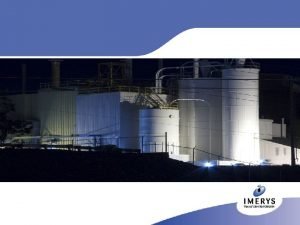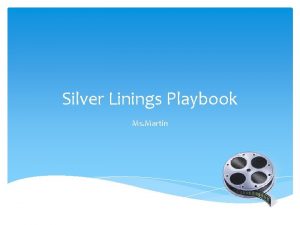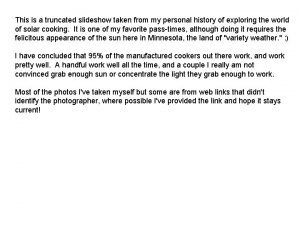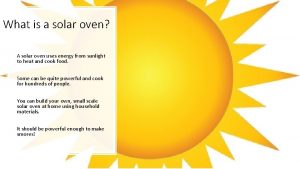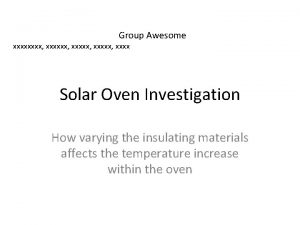Solar Oven Investigation How different linings affect oven





- Slides: 5

Solar Oven Investigation How different linings affect oven performance

Experimental Question • How does lining the interior surface of a solar oven with different materials impact the oven’s performance.

Procedure 1. 2. 3. 4. 5. Materials: 4 cardboard boxes (32 cmx 25 cmx 8 cm) with no lid, 5 thermometers, black paper, white paper, aluminum foil, saran wrap, tape. The ovens were lined as follows: – – Oven 1: no lining, bare cardboard Oven 2: single layer of black paper lining bottom and inside of walls. Oven 3: single layer of aluminum foil lining bottom and inside of walls. Oven 4: single layer of white paper lining bottom and inside of walls A thermometer was placed in each box, then Saran wrap was stretched over the top “window” and tape was used seal the oven. Ovens were placed outside in direct sunlight and positioned so that the sun was hitting the window as directly as possible. Temperatures of the ovens and of the surrounding air was monitored for 20 minutes.

Data/Results Lining aluminum foil white paper cardboard black paper Temp. Rise (o. C) 22 31 31 40

Conclusion Solar ovens perform better when they have a dark surface that absorbs the sunlight, and do less well if they reflect a lot of the light. Every oven started to warm up immediately when placed in the sunlight, but temperatures plateaued by the end of the testing period. The solar oven lined with black paper performed the best with a temperature increase of 40 o C. The oven with bare cardboard, and the one lined with white paper rose by 31 o. C while the oven lined with Aluminum foil only warmed by 22 o. C. Solar ovens experience an increase of thermal energy as a result of absorbing electromagnetic waves from the sun. The walls/floor of the oven reflect some of these waves and absorb the rest. Black paper appears dark because it does not reflect much visible light so we know it is absorbing a high percentage of the electromagnetic waves. The aluminum foil acts like a mirror that reflects the energy from the sun back out of the oven. The thermal energy of the oven walls/floor increases as the sunlight they absorb causes molecules in the oven wall to “wiggle” more. The air in the oven does not absorb much solar energy directly, but there is a transfer of energy when molecules of air bounce off of the oven walls/floor. A hot dog in the oven would be warmed by molecules of air colliding with it. Half of the sun’s energy is in the visible part of the spectrum and half is in the infrared which can’t be seen with our eyes. While black paper worked the best of the four materials we tested, It would be useful to find out if other materials might do a even better job at absorbing both visible and infrared radiation. It could be argued that the thin layer of material we added further insulates the oven and slows the transfer of heat by conduction to the cool air outside. However, the similar performance of the bare cardboard and the box lined with white paper suggests that this size effect must be small compared to the impact of how the surfaces absorb/reflect sunlight.
